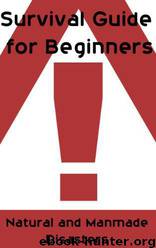Survival Guide for Beginners by Vitaly Pedchenko

Author:Vitaly Pedchenko
Language: eng
Format: mobi
Published: 2012-12-09T07:00:00+00:00
CHAPTER 14 - MEDICAL SUPPLIES AND FIRST AID
Medical kits are critical in a survival situation and your medical supplies should be close to 50 percent of your overall survival kit. You may have to treat yourself and others when professional medical care is not available to save your life or another's. Before setting out on any adventure or when preparing a survival kit for emergencies, redundancy will save lives. Every person or family member should have his or her own well-stocked medical kit and everyone should have a working knowledge of emergency medical treatment. When administering first aid always use the kit of the injured individual first. This ensures you have supplies if you become injured.
Combat medics always reach for the compression bandage a soldier is carrying on his or her load bearing belt or harness.
First aid kits off the shelf are a good starting point but for some situations, you may be required to stitch up wounds to stop bleeding and to administer medications such as anti malarial drugs or broad-spectrum antibiotics. Your medical kit can be expanded beyond the typical items found in most kits.
1. Doxycyline is one of the few broad-spectrum antibiotics used for the treatment of Rocky Mountain spotted fever and it is used to treat Lyme disease and E. coli and other bacterial infections. Doxycyline is typically used in conjunction with quinine for the initial treatment of malaria and is considered an anti malaria drug. Ask your health care provider to prescribe this drug if you expect to be in areas where malaria, contaminated food and water may be a problem.
2. Rochephin is an antibacterial drug that can be administered intravenously or injected into a muscle group. The drug in powdered form is water-soluble. Rochephin is used to help reduce drug resistant bacteria.
3. Zithromax or Azithromycin is another antibacterial drug typically used to treat typhoid, which you can get from drinking contaminated water. It also is used to treat pneumonia, strep throat and other bacterial infections. Ask you health care provider to prescribe broad-spectrum antibiotics. The drugs are not considered a controlled substance and are readily available in most pharmacies; however, they must be prescribed by a medical doctor.
4. Suture kits for individuals typically come with a variety of needles pre-threaded for various sized wounds. The needles once used are considered disposable. Open wounds are susceptible to infections and larger ones may have to be stitched closed to slow bleeding and to prevent infections.
5. Betadine is the brand name for 10% Povidone-iodine that is quality topical antiseptic used in hospitals and doctors' offices. You should have this in your kit for wound treatment to kill bacteria in and around wounds. Most off the shelf kits will have packets of Betadine or the generic version. The solution can be in liquid or swab form.
6. Imodium to control diarrhea
7. Ibuprofen and other over the counter medications used as pain killers and anti-inflammatory medication
8. Solar Blanket
9. Laser Pointer For Signaling
10. Mirror
11. Ophthalmic topical antibiotic ointment typically used to treat eye infections
12.
Download
This site does not store any files on its server. We only index and link to content provided by other sites. Please contact the content providers to delete copyright contents if any and email us, we'll remove relevant links or contents immediately.
Periodization Training for Sports by Tudor Bompa(8110)
Bodyweight Strength Training by Jay Cardiello(7814)
Therapeutic Modalities for Musculoskeletal Injuries, 4E by Craig R. Denegar & Ethan Saliba & Susan Saliba(7669)
Born to Run: by Christopher McDougall(7037)
Imperfect by Sanjay Manjrekar(5754)
Wiseguy by Nicholas Pileggi(5621)
Shoe Dog by Phil Knight(5088)
Paper Towns by Green John(5046)
The Body: A Guide for Occupants by Bill Bryson(4903)
The Rules Do Not Apply by Ariel Levy(4804)
Endurance: Shackleton's Incredible Voyage by Alfred Lansing(4639)
Tuesdays with Morrie by Mitch Albom(4618)
Bodyweight Strength Training Anatomy by Bret Contreras(4586)
Yoga Anatomy by Kaminoff Leslie(4256)
The Sports Rules Book by Human Kinetics(4228)
Science and Development of Muscle Hypertrophy by Brad Schoenfeld(4068)
Dynamic Alignment Through Imagery by Eric Franklin(4059)
Machine Learning at Scale with H2O by Gregory Keys | David Whiting(3997)
Alive: The Story of the Andes Survivors by Piers Paul Read(3935)
